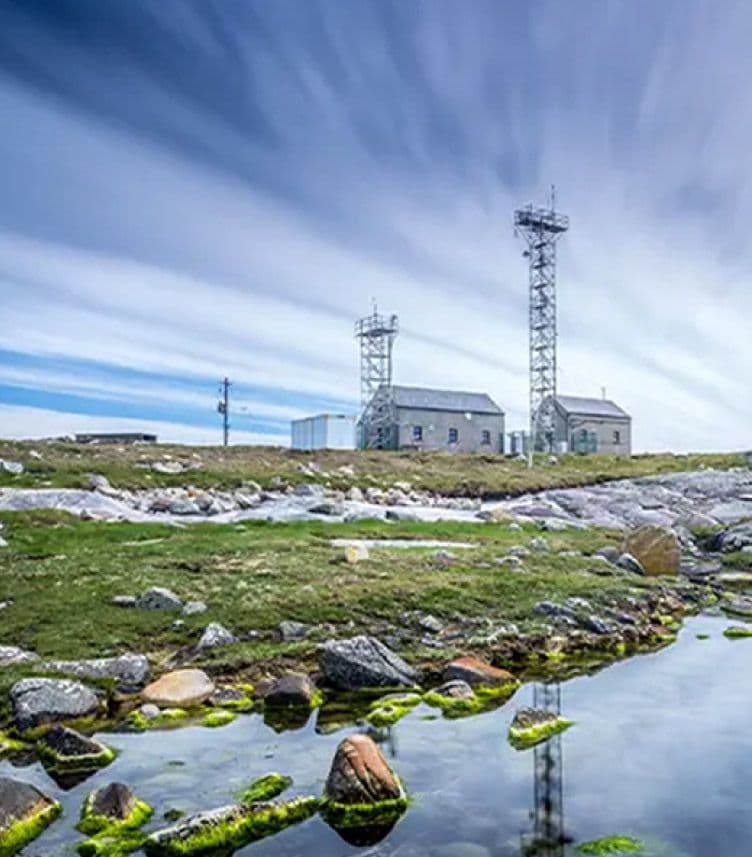CASE STUDY
An evaluation of the AtmospherIQTM optical bench for long-term atmospheric monitoring
Continuous monitoring of atmospheric N2O, CH4, and CO2 requires instruments that meet strict accuracy, precision, and stability requirements. In addition, instruments must be durable because they operate continuously, all day, every day. LI-COR AtmospherIQ Gas Analyzers are designed to solve these problems and enable more widespread and complete atmospheric gas monitoring around the world.
This article describes a test deployment of gas analyzers using the AtmospherIQ optical bench at the Mace Head Atmospheric Research Station in Ireland. Results show that instruments satisfy performance requirements for data collection and submission to ICOS and World Meteorological Organization Global Atmosphere Watch (WMO GAW) networks.
Test Setup
Instruments featuring the AtmospherIQ optical bench were deployed for six months at the Mace Head Atmospheric Research Station in Carna, County Galway, Ireland. The two instruments were operated in parallel with a permanently installed gas analyzer that provides data to both ICOS and WMO GAW networks.
The Atmospheric Research Station at Mace Head has a tall tower with an air inlet located at the top that samples atmospheric air, which is delivered to several gas analyzers housed in the buildings at the base of the tower (Figure 1). The analyzers measure atmospheric air continuously, with periodic pauses to measure calibration gases. Gases delivered to the analyzer are controlled with a multi-port rotary valve (Figure 2). Instrument data and valve port selection is controlled using GCWerks software, which includes calibration routines for LI-COR gas analyzers.

Photographer Gavin Kelly. Copyright Colin O'Dowd. Reprint permission granted to LI-COR.
Figure 1. The atmospheric monitoring station at Mace Head has a tower where samples are collected and a building for gas analyzers and measurement infrastructure.

Figure 2. The gas sampling system at Mace Head includes a particle filter, air intake, pressure vent, valve selector system, gas standards, gas analyzers, and a data collection system.
Results
Linearity corrected ambient CH4 data over a six-month period, from July 2020 to January 2021, shows comparable performance of CH4 measurements. During this evaluation there were short periods where data were not collected due to site maintenance and other issues not related to instrument operation/performance. These periods are evident in the data presented.

Figure 3. Linearity corrected ambient CH4 data collected by the LI-COR analyzer featuring the AtmospherIQ optical bench (LI-7810) and Picarro analyzer. Charts displayed include mixing ratios (top), differences (middle), and ratio (bottom).
Similarly strong performance is observed for CO2 measurement data. For CH4, with a water removal regime in place (an ICOS station requirement), a difference between measurements of ~1 ppb is observed (~0.05% of full-scale, typical background CH4 concentration of ~2000 ppb). Without water removal, variability in water concentration may lead to this difference increasing to ~4 ppb (~0.2% of full-scale, typical background CH4 concentration of ~2000 ppb). For CO2 measurements, differences were typically around 0.1 ppm (~0.025% of full-scale, typical background CO2 concentration of ~400 ppm). Differences of ~0.1 ppm were observed, irrespective of the water removal regime deployed, including total absence.
Conclusions
Previous independent testing by ICOS Atmospheric Thematic Centre (ATC) and Scripps Institution of Oceanography were encouraging because they showed that instruments featuring the AtmospherIQ optical bench are suitable for long-term background measurements of atmospheric CH4 and CO2, respectively. The longer test at Mace Head provided additional confidence in the suitability of the platform for continuous monitoring applications. Results from this test show that the instruments are suitable for long-term deployments.
These evaluations show the suitability of the AtmospherIQ optical bench for atmospheric monitoring, with demonstrated compatibility with WMO GAW and ICOS standards and protocols.
Acknowledgements
- Damien Martin, National University of Ireland, Galway, Ireland
- Gerard Spain, Mace Head Research Station, Galway, Ireland
- Dickon Young, University of Bristol, UK
- Michael Geever, National University of Ireland, Galway, Ireland
- Peter Salameh, Scripps Institution of Oceanography, La Jolla, CA, USA
- Simon O'Doherty, University of Bristol, UK